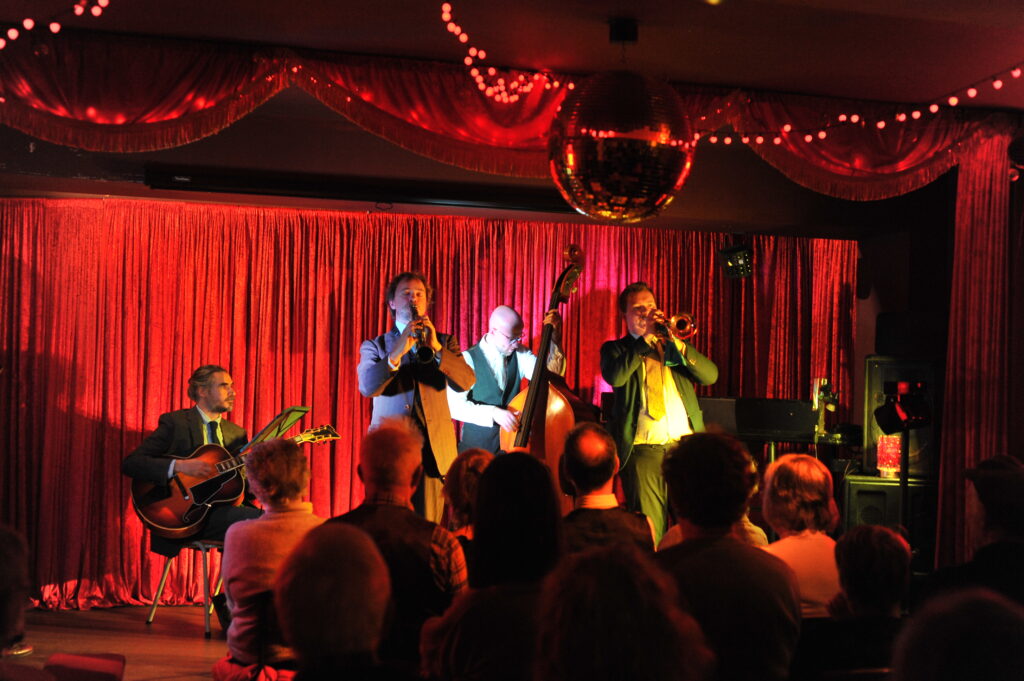Erik, Olav, and Max Show the Way Forward
TOM BLASS in Hastings Independent Press on the Cable Street Rag Band
Jazz is a funny world. It has its deities of course: Coltrane, Miles, Bird, Monk, Billie and Ella et al, towering above mere mortals from their Olympian heights. Below that exalted circle is a denominational splintering, and while some jazz fans discern no contradiction between their loves for Bix Biederbecke and Carla Bley, for Ayler or for Engelbert, others are wedded to their sub-genres. Clamorous big band makes bop-heads wince. Bossa Nova is too saccharine for devotees of late Coltrane. Free jazz makes for incomprehensible noise to those for whom a beat and a key are indispensable aids to listening.
But good jazz is a breed that trumps all distinctions, and it is in this category that Ewan Bleach’s Cable Street Rag Band belongs, exultant at Decimus Burton’s old show home of Crown House on St Leonards seafront.
The Cable Street Rag Band is described on Bleach’s website as “Where Limehouse meets New Orleans”. In other words, the street that gives the band its name is forever associated with the march against the Blackshirts in the 1930s, i.e. a good fight that still needs fighting. But his band’s tunes are not obviously pugilistic.
On his website, Bleach says that he “specialises” in the early styles of jazz, ragtime, blues and swing, and says his “interest lies primarily in old sensibilities of pre-war music… for dancing and romancing”, which does sound a little schmaltzy at face value. In fact the event, which brought to life a wonderful medley, was executed with glorious brio but complete absence of past-wallowing or lily-gilding. They swung through ballads and tight instrumentals with verve, lightness of touch, and a kind of musical honesty that brought them bang up to date.
Bleach’s playing, both on tenor sax and clarinet was superb. And — if one might stop short of calling him a ‘singer’ — his voice suited the musical setting admirably and correctly. Double-bass (Harry Evans), trumpet (Lewis Taylor), and guitar (John Kelly) were all distinct and brilliant in their own right and as an ensemble, consummately-well coordinated and respectful of each other’s playing.
The ‘guest player’ for the evening was St Leonards’ own musical superstar, the violinist Max Baillie, whose exquisite – if ever so slightly diffident on this occasion – violin added a Grappellicity, a poignancy, wherever it contributed. The repertoire included familiar standards (All of Me, Way Down Yonder in New Orleans, Bouncin’ Around) – and rarities by early Brazilian and Venezuelan jazz composers and other less-heard masterpieces, all of which evidenced considerable research on Bleach’s part.
But here was the thing: while the evening sipped, nay dipped, freely from past decades amid the cabaret-style setting, it served as a kind of reminder that, tempting though it might be to imagine otherwise, this was music that sprang not from innocence, but from periods of great unrest and change: racial inequality, economic turmoil, and the prospect, reality or aftermath of war. And somehow because of that, here and now, these old tunes seemed neither quaint nor dated, but curiously pertinent reflections of, or deflections from, a troubled age.
Chapeau to Baillie (who in this case was not only hired fiddle, but indeed the impresario) for bringing Bleach to St Leonards – and to Bleach for bringing his rag band along too. My sense was that everyone who attended really liked it. Body and Soul.

